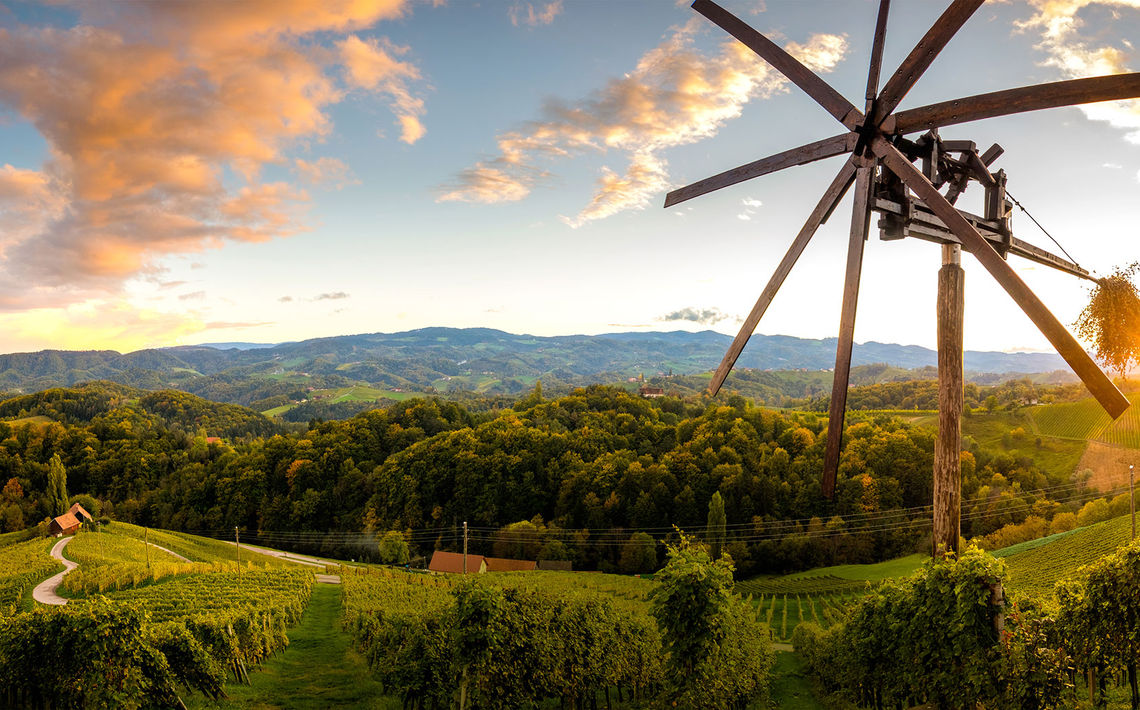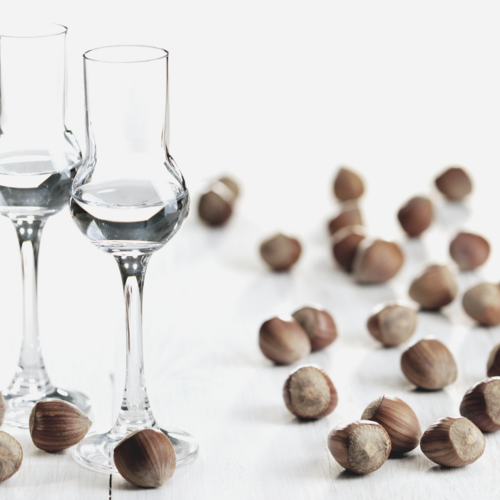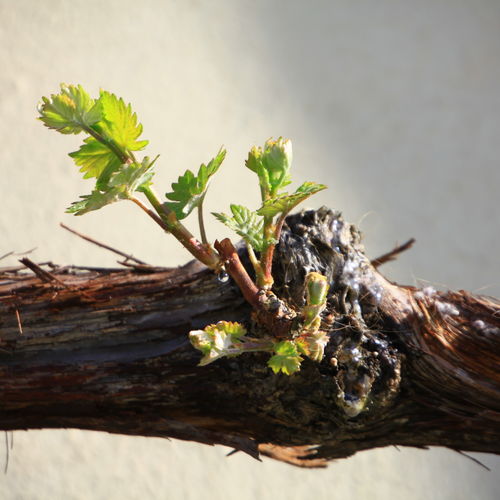Winegrowing Slovenia
Slovenia is a country with a favourable position, which enables the production of top quality wines.

Vines had spread throughout Slovenia by the time of the Celts, though it is the Romans that are most deserving for the development of the first forms of viticulture on our soil. At the crossroads of the Mediterranean, pre-Alpine world, and Pannonian Plain the climatic conditions are very favourable for the cultivation of noble grape vines. Slovenia has more than 33,000 hectares of vineyard, which are almost exclusively on steep hills. Many of our professional vineyards are listed among the top 5 percent of the vineyards around the world which enable the production of top quality wines.
In Slovenia, there are three wine regions: the Podravska, Posavska and Primorska wine regions.
The Podravje Wine Region has a size of 9650 hectares and is in the northeast of the country. It is divided into two districts: Styrian Slovenia (8685 hectares) and Prekmurje (965 hectares).
Geography: The Podravje wine region has a distinctly hilly landscape with the vineyards averaging an altitude of between 250 and 400 metres.
Soil: Most of the soil is the result of carbonate rock and Pleistocene clay, which is a favourable basis for the development of grapevines.
Climate and precipitation: The climate has continental characteristics, with an average annual rainfall of about 1000 mm, with hot summers and cold winters.
Varieties most represented: Riesling, Šipon, Rhine Riesling, and Chardonnay and Pinot.
The Posavje wine region covers an area of 4328 hectares of southwestern Slovenia that is divided into three districts: Dolenjska (2456 hectares), Bizeljsko Sremič (1264 hectares) and Bela Krajina (608 hectares).
Geography: A medium hilly landscape is crisscrossed by many narrow valleys and distinctly steep slopes where the vines prevents soil erosion.
Soil: Mainly composed of marls and sandstone with a calcareous binder. In most areas where Cviček is grown, it is dominated by limestone and dolomite.
Climate and precipitation: The average annual rainfall is between 1070 and 1200 mm, with the characteristics of continental climate and the effects of colder alpine climate.
The most represented varieties: Mostly red varieties dominate this area, among which Žametovka is the most represented, followed by Riesling, Modra Frankinja, Kraljevina and other varieties.
The Primorska wine region is 8081 hectares and is located in the west of Slovenia, it is divided into four districts: Vipava (3005 hectares), Slovenian Istria (2331 hectares), Goriška Brda (1992 hectares) and the Karst (753 hectares).
Geography: Coastal vineyards stretch from sea level to an altitude of around 360 meters.
Soil: Developed on flysch, limestone and dolomite, which on Karst leads to the development of its famous brown soil - terra rossa. “Rigolana soil” is noteworthy because it is formed under the influence of a human deep ploughing with special plods that are a typical part of the tradition at that wine-growing location.
Climate and rainfall: There is an average annual precipitation of around 1460 mm, with hot summers and it rarely sees snow in the winter.
The most represented varieties: Mainly red, with Refošk (refosco) being the most common variety, followed by Rebula (Ribolla), Merlot, Malvasia, Chardonnay, Sauvignon, Cabernet Sauvignon and others.
WINE GROWING DISTRICT STYRIA SLOVENIA
Slovenian Styria is the largest of all Slovenian districts. It has a varied landscape, with steep slopes in Haloze, terraces in Ljutomersko Ormoške Gorice, and the city of Maribor, which can boast of a vineyard in the middle of town and the oldest vine in the world. In the northern part, the hilly area ends with Radgonsko Kapelske Gorice that then descends towards the Mura river in Panonska nižina (Pannonian plain).
The district has a history of being in a well-known position that ranks among the top 5 percent of the vineyard locations in the world. Suitable soil and favourable climate in Styria enable a rich diversity of grape varieties. The soil developed on soft carbonate rocks, so the soils are brown, marl is the one substrate which is favourable for vines. Pannonian, respectively the sub-Pannonian air climate (which features a larger temperature difference between day and night, relatively dry summers, and real winters), and the related peak rainfall in the summer, have a positive impact on flora and thus also on the vines. In autumn, there is less rainfall but more sun which is favourable for the warmth of loving vines.
The Styrian Slovenian wine-growing district is famous for its elegant, distinctive varietal white wines and types. The economical grape production allows for several varieties, from early to late ones, from white to red, from the non-aromatic to aromatic, from those who give pleasant drinking wines to those that offer the possibility of production of quality and fine wine. The ratio between white and red varieties is in favour of white wines as these are planted in more than 95% of the vineyards.
Under the influence of the hot and dry Pannonian climate, we can grow good dry and semi-dry wine varieties and types as well as top semi-sweet and sweet wines of specific quality such as late harvest, selection, berry selection, ice wine and dry berry selection. These wines reflect the golden yellow colour, delicate bouquet, with a rounded noble character of noble rot. The tastes are typically full, rich with extract, nobly rounded and passionate. This wine-growing area provides favourable conditions to produce sparkling wines - sparkling wines made both ways, by the Charmat method as well as the classical process of fermentation in the bottle.
Since Slovenian Styria is the largest district in our country, there is the possibility of connecting positions and varieties together to make wines which were previously drunk by royal families throughout Europe.
SOME FACTUAL DATA ABOUT WINE GROWING IN SLOVENIA
(adapted from information provided by the Ministry of Agriculture, Forestry and Food of the Republic of Slovenia’s website using data dating back to 2015):
- The production of wine is between 800,000 and 900,000 hl per year.
- Slovenia’s wine growing area is divided into three regions and nine districts.
- The register of grape and wine producers (RPGV) has enrolled more than 16,000 hectares of vineyards (aerial photographs show that the territory of the Republic of Slovenia has almost 19,300 hectares of vineyards).
- RPGV has enrolled 30,000 grape producers, and almost all of them are producers of wine as well, bottling has registered more than 2,300 growers, of which 11 are large operations (over 500,000 litres a year).
- Registered growers reported a total 46 million litres of 2014 vintage wine. These amounts of wine represent the officially recorded volume of wine in Slovenia appearing on the market. In addition to this amount of wine, it is estimated by MAFF that about 30-40% of the wine produced is by small producers and is devoted to self-sufficient growers and their families.
- The integrated production includes 8500 hectares, ecological production is 400 hectares of vineyards.
- In Slovenia, there are 48 varieties of grapevine are grown (Vitis vinifera).
- The vineyards are located on steep slopes, which means on the one hand they are highly expensive to produce but on the other hand it enables high-quality grapes. The proportion of quality wine produced represents 70% of production.
- Imports and exports were balanced in recent years, last year imports increased, but we mostly import table wine, which according to the structure of production and consumption is lacking.
- In 2014, exports reached 7.6 million litres. In recent years, the main markets for Slovenian wines are: Germany, USA, Croatia, Netherlands, Bosnia and Herzegovina and the Czech Republic. Imports in 2014 reached 12.8 million litres. Macedonia, Italy, Germany and Hungary are the main countries exporting to our market.
- In Slovenia, the consumption of wine is in the decline, so winemakers have been increasingly reaching out to foreign markets to sell larger shares of the crop.
 url.greenkey
url.greenkey 



